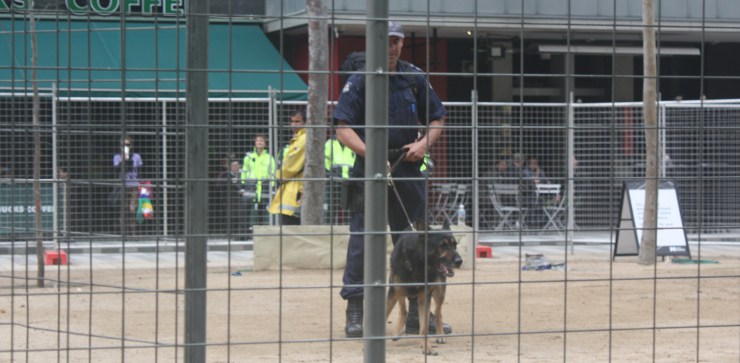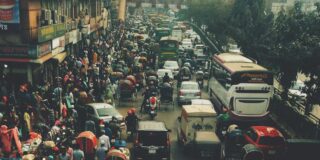
By James Muldoon.
These new laws are not about justice, they are about power – the power to control who and what is visible in public space and the circumstances in which they appear. The Summary Offences and Sentencing Amendment Bill is the latest strike in a political struggle over what constitutes legitimate use of public space, targeted at political protesters and the poor alike.
We are accustomed to viewing laws as universal and impersonal edicts, applying objectively to all citizens regardless of sex, race, class or religion. This is the classical vision of liberalism and a view that we like to have of our legal system. But it is difficult to see these new laws as anything but a targeted and strategic offensive against unions and organised political protests. Behind the visage of attempting “to better protect the community from lawless behaviour,” the true motives of Attorney-General Robert Clark are apparent: the bill aims “to give police clearer and more effective move-on powers and to create longer lasting exclusion orders.” This is the crux of the bill: an enormous expansion of police “move-on” powers and the removal of the important exemption of political protests. The elimination of the carve out for political protests makes community pickets and protests extremely vulnerable to being shut down by the government and thus substantially reduces our freedom of expression and freedom of assembly as set out in the Victorian Charter of Human Rights and Responsibilities.
The controversial police move-on powers were first introduced in Victoria in 2009 in a bid to crack down on alcohol-related violence. Liberty Victoria, the Federation of Community Legal Centres and a number of other groups opposed the introduction of these laws at the time, arguing that they were undemocratic and an intrusion on civil liberties. Deputy Commissioner Kieran Walshe justified the introduction of the laws on the grounds that they would protect the “community’s rights to be safe.” This façade of public safety has since fallen away, with the Attorney-General now openly declaring his desire to remove the “union-friendly restrictions” on police move-on powers in relation to political protests and pickets. These new, presumably “government friendly,” laws are political through and through. In the second reading speech of the bill, Mr Clark stated that the “move-on powers may be used in respect of people engaged in picket lines, protests and other demonstrations.” He has also admitted that the laws “pose a limitation on an individual’s right to move freely within Victoria … and may, in certain circumstances, limit the rights to freedom of expression (section 15), and peaceful assembly and freedom of association (section 16).” The Murdoch press has chimed in, congratulating the government on its “new laws to smash union picket lines.”
This bill is the latest move by the government in a long cat and mouse game with the political Left. One of the reasons for the introduction of these new laws was the growing perception of a deficiency in police powers for controlling large groups of protesters. Evidence of this comes from the legal debacle of the 2011 Occupy Melbourne eviction, in which senior police officers were unclear on which powers they were able to rely upon to evict the Occupy protesters from City Square. Were protesters breaching the peace, trespassing on private property or committing an offence under local by-laws? Were police using their statutory move-on directions or common law powers to prevent breaches of the peace? Inspector Bernie Jackson would later provided a different explanation of police actions than were given by officers on the day.
A study undertaken by the University of Queensland and Queensland Public Interest Law Clearing House has shown that 76.5 per cent of the people surveyed experiencing homelessness had been told to move on one or more times in the last six months.
Further evidence of the need for a rewriting of the laws can be garnered from the concerted efforts of community groups organised against the controversial and secretive East-West link tunnel. In this case, police have struggled to keep up with the innovative and diverse tactics of protesters attempting to disrupt the construction of the tunnel and have been forced to deploy huge resources to the test drilling sites. Police can see that the core of the protest is composed of a dedicated group of community organisers. If these individuals could be banned from the protest sites by exclusion orders, police believe that it would cripple the efforts of the community picketers and effectively quash the protest.
But the main target of these laws, the big fish on the end of the line, is the union movement in Victoria. The government is keen to crush the remaining power of the unions through outlawing and delegitimising one of their strongest weapons: pickets. Stephen Jolly, a City of Yarra Councilor and a delegate with the Construction, Forestry, Mining, and Energy Union (CFMEU) states, “In the long run they’re aimed against the trade union movement. Everyone knows the CFMEU is the jewel in the crown of Australia’s trade union movement. The right wing, the bosses, the Liberals, they’ve got the CFMEU in their sights. If they can smash the CFMEU … they can crush trade unionism in Australia.” These laws also come in the context of a renewed attack on unions by the Abbott government and a costly dispute between the CFMEU and Grocon.
The clearest indication of the political and strategic nature of these laws comes from an examination of their operation and effect. First, there is the dramatic expansion of police powers to cover a range of new circumstances. Police move-on orders that direct people to leave a public place will be extended to include people who are likely to or are causing an “undue obstruction,” “impeding another person from lawfully entering or leaving premises,” “causing a reasonable apprehension of violence in another person,” or indeed anybody who has committed “an offence in the public place” in the past 12 hours. These laws are designed to target unions and anybody else involved in political pickets or other forms of obstructive political actions.
Greater police discretion means more power for those in charge and more ability to use force when it is expedient
Second, there is the large increase in penalties and the introduction of new exclusion orders. A person found in breach of a move-on order can be arrested and fined $720. This is no loose change for an average worker and would constitute a huge deterrent for the expression of political opinions. Furthermore, where a person fails to comply with multiple move-on directions the police can apply for an exclusion order, which would ban a person from a particular area for up to 12 months. The government is targeting experienced community organisers and activists, since the laws would effectively bar protest organisers from a protest site if they received a sufficient number of move-on directions. The breach of an exclusion order is punishable by up to two years imprisonment, enough to stir even the most serial of pests. If these laws were applied to the current East-West tunnel picket it is not out of the question that many of the protesters there (which include a number of elderly residents) would end up with serious jail terms.
One of the key issues with these laws is that they are so broad they could have a number of unintended consequences. A significant problem, identified by Fitzroy Legal Service solicitor, Meghan Fitzgerald, is the inclusion of arrest powers in cases where police hold a reasonable suspicion that a person may engage in future possible illegal conduct. “As soon as the move-on direction is issued, on a reasonable suspicion that your conduct, including future conduct, is likely to cause a breach of the peace, then people can be arrested,” she said. As well as conjuring up images of the future crimes division on sci-fi flick, Minority Report, it presents the very real possibility of citizens being arrested without actually having committed an offence on the grounds that police suspect that they are likely to engage in some form of prohibited conduct.
Merely standing in the vicinity of a blockade or picket could see you “moved on” and arrested. The bill also allows for police officers to issue move-on directions to an entire group of people on the basis of a single individuals’ conduct. The notion of a “reasonable suspicion” is an extremely low threshold and opens up incredible discretionary power. “A suspicion is basically an unfounded belief,” Ms Fitzgerald said, “It is a subjective judgment made in cases where there need be no evidence to support it, and it can be relied upon to enforce absolute compliance.”
The oversight of judges of these new laws offers no real relief. The road of judicial review of a police action is long, costly and unlikely to have any serious impact on time-sensitive political protests. As soon as police are given powers it becomes the classic case of the strong doing what they can and the weak suffering what they must. In a comment made by Superintendent Brett Guerin last year in relation to motorcycle gangs, of which the irony was perhaps lost on him, he stated, “we have a gang too – it is called the Victoria Police. And I’ll give you a tip. Our gang is bigger than your gang.” And indeed Victoria Police is the biggest gang around, well-resourced, equipped and able to physically wipe out any political protest that might challenge the government, which is precisely why they should not be given these wide-ranging new powers.
The new powers could also be applied in arbitrary and possibly discriminatory ways. The discretionary power of police officers presents the opportunity for selective treatment and abuse. Such subjective discretion has been proven to disproportionately effect vulnerable sectors of the community. Evidence from other states within Australia has demonstrated that discretionary police powers, and move-on laws in particular, will be most likely used against groups who already suffer from prejudice and discrimination. A study undertaken by the University of Queensland and Queensland Public Interest Law Clearing House has shown that 76.5 per cent of the people surveyed experiencing homelessness had been told to move on one or more times in the last six months.
In Victoria, the laws include provisions that allow move-on directions to be given to persons “intending to unlawfully procure or supply, a drug of dependence” or who “have committed, within the last 12 hours, an offence in the public place.” These particular sections are well suited to facilitate social exclusion without the persons affected having ever committed a crime. The mere suspicion of a police officer that a person may be in a public place to buy or sell drugs, or that they have committed a minor misdemeanor, such as jaywalking or a failure to pay for a public transport ticket, is enough to activate these new laws. As they come in to force there is a risk that these laws will be used to further marginalise and criminalise some of Victoria’s already most disadvantaged. The bill will facilitate the policing, both literal and metaphoric, of the use of public space.
Ultimately, these laws are unnecessary because the police already have powers to arrest people who are breaking the law. It is clear what the new laws are about: political control and shutting down dissent. From the standpoint of Premier Napthine and the government, citizens expressing dissenting views through protest or picketing is an unwelcome inconvenience. Greater police discretion means more power for those in charge and more ability to use force when it is expedient. It is good news for someone in power looking to get their way and bad news for anyone who may disagree with them.
Will the laws be knocked out by the courts? It is certainly possible. The weakness of this prospect lies in that in a number of recent decisions, such as Monis and Corneloup. The High Court of Australia has taken a relatively limited reading of the freedom of political communication, which does not bode well for potential legal challenges to the laws on grounds that they are incompatible with the Victorian Charter or the Australian Constitution. But these laws introduce extremely broad and vaguely defined powers that may well be found to run afoul of either the statutory or implied rights.
Labor has already indicated that they oppose the laws, so there is the possibility that they would be repealed by an incoming Labor government in November. But most importantly, history has shown that unpopular draconian laws can be stopped through mass mobilisation. In Quebec, on 18 May 2012, the government passed Bill 78, an anti-protest law that sought to manage the growing waves of student protests against a proposed hike in tuition fees. Student unions, workers’ unions, opposition groups, and even the Quebec Bar Association opposed the law and held nightly demonstrations for over a month. After continual protesting against the law, the Liberal Party was voted out of office on 4 September 2012 and the law was immediately repealed.
But it should not be forgotten that in Victoria it was Labor who originally brought in police move-on powers and that a strong law and order agenda has been supported by both major parties at a state and federal level. The laws are set to come in to force at the latest by 1 September 2014, but one can imagine that the government will be eager to continue works on the East-West tunnel and that the laws will be brought in sooner rather than later. What is certain is that by eroding basic civil rights, undermining political protest and further marginalising young people and those experiencing homelessness they will change the face of Australian democracy.
James Muldoon is a political theorist and philosopher who has taught at Monash University, Swinburne University and the Melbourne School of Continental Philosophy.
For more on these new laws, listen to Lizzie O’Shea’s interview on Right Now Radio:




